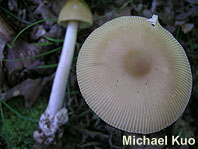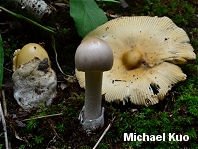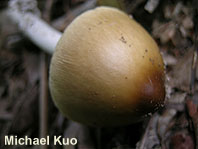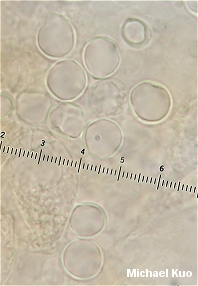| Major Groups > Gilled Mushrooms > Pale-Spored > Amanita > Amanita sinicoflava |

|
Amanita sinicoflava [ Basidiomycetes > Agaricales > Amanitaceae > Amanita . . . ] by Michael Kuo This subtly beautiful Amanita is a member of the Amanita vaginata group; like the other species in the group it lacks a ring and features a strongly lined cap margin, as well as a sacklike volva. Amanita sinicoflava can be separated from the others without a microscope on the basis of its "Chinese yellow" to olive tan or olive yellow cap and its volva, which usually stains gray to black by maturity. It often features a small, darker (and usually raised) area over the center of the cap. It is fairly widely distributed east of the Great Plains, and appears under hardwoods or conifers. Description: Ecology: Mycorrhizal with various conifers and hardwoods; growing alone or gregariously; summer and fall; fairly widely distributed east of the Great Plains. Cap: 2.5-7 cm; bell-shaped, expanding to broadly bell-shaped, convex, or nearly flat; sticky or dry; sometimes with a few whitish or grayish patches that are easily lost; olive tan to olive yellow, often darker over the center; the margin prominently lined. Gills: Free from the stem or nearly so; close or nearly crowded; whitish, developing grayish tones with age. Stem: 6-14 cm long; up to just over 1 cm thick; tapering slightly to the apex; without a basal bulb; white; discoloring a little brownish on handling; base encased in a loose but fairly persistent sacklike volva that is initially white but discolors grayish to blackish with maturity, beginning with the upper edge. Flesh: Whitish; unchanging. Odor: Not distinctive. Spore Print: White. Chemical Reactions: KOH on cap surface negative. Microscopic Features: Spores 8-15 µ; globose or subglobose; smooth; inamyloid. Basidia primarily 4-spored; without basal clamps. Pileipellis a cutis or ixocutis of filamentous hyphae. Lamellar trama bilateral; subhymenium ramose to cellular. REFERENCES: Tulloss, 1988. (Phillips, 1991/2005; Roody, 2003; McNeil, 2006; Tulloss, 2013.) Herb. Kuo 09029505, 07110704, 07140702, 07011302. Further Online Information: This site contains no information about the edibility or toxicity of mushrooms. |
© MushroomExpert.Com |
|
Cite this page as: Kuo, M. (2013, May). Amanita sinicoflava. Retrieved from the MushroomExpert.Com Web site: http://www.mushroomexpert.com/amanita_sinicoflava.html |



